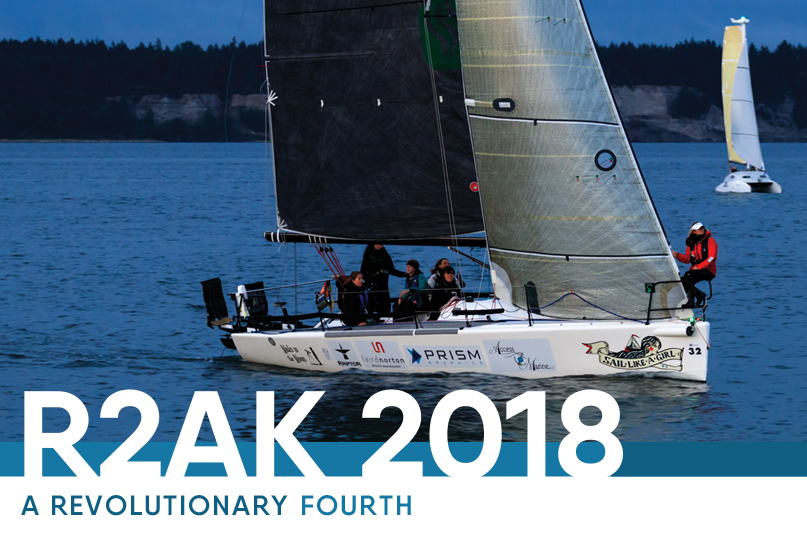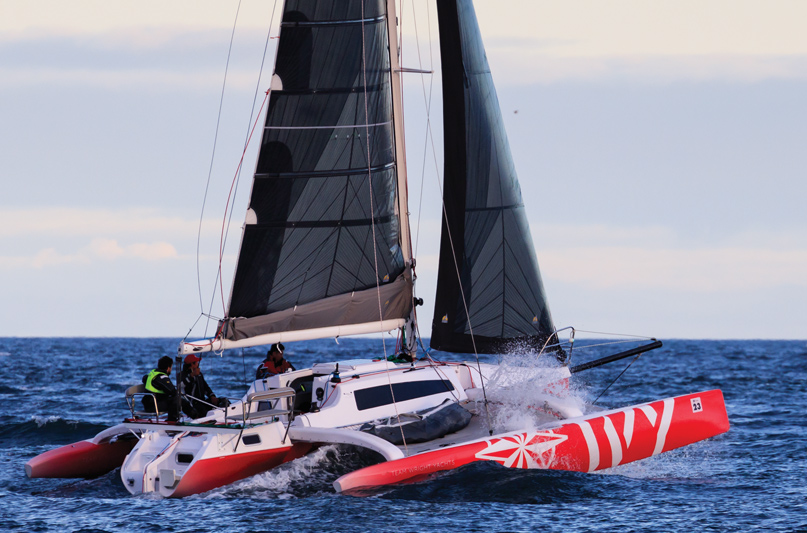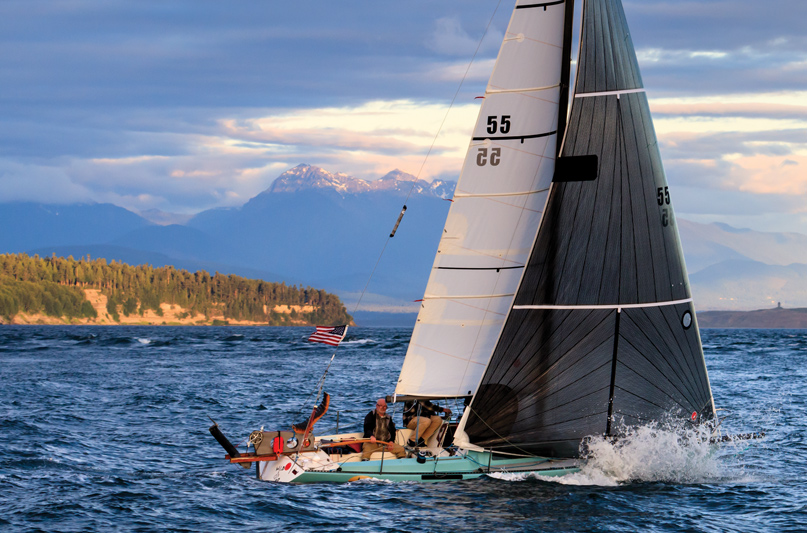
 During R2AK’s first three years of existence (2015 to 2017), a pattern began to define the race’s identity. Insane, bitterly cold storms drove drenched competitors to sleep in their drysuits while performance multihulls with two to four (male) crew dominated the top rankings. The leaders always reached Ketchikan in about four days. Even the greatest hopes for the monohulls—Olympian Carl Buchan on his famous Madrona and beloved team Skiff Foundation Jungle Kitty—came up short in 2016 (fourth and second respectively) surrounded by performance multihulls. The verdict, especially from the always present armchair sailors online, was in. Perhaps the world’s wildest, most unpredictable sailing adventure race was becoming *gasp!* predictable.
During R2AK’s first three years of existence (2015 to 2017), a pattern began to define the race’s identity. Insane, bitterly cold storms drove drenched competitors to sleep in their drysuits while performance multihulls with two to four (male) crew dominated the top rankings. The leaders always reached Ketchikan in about four days. Even the greatest hopes for the monohulls—Olympian Carl Buchan on his famous Madrona and beloved team Skiff Foundation Jungle Kitty—came up short in 2016 (fourth and second respectively) surrounded by performance multihulls. The verdict, especially from the always present armchair sailors online, was in. Perhaps the world’s wildest, most unpredictable sailing adventure race was becoming *gasp!* predictable.
For R2AK, a race inspired by the beer-side nautical philosophizing of Northwest Maritime Center organizers like Jake Beattie, predictability is perhaps the worst fate of all. Central to the minimally regulated glory of R2AK is that all designs can have their day in the same event, from standup paddleboards to the Marstrom M32 catamaran of MAD Dog Racing, which still holds the time record: 3 days, 20 hours, 6 minutes from 2016’s race.
The convoluted geography of the Johnstone Strait, the brutal tidal swings of Seymour Narrows, and the unpredictability of the open blue of the North Pacific beyond Queen Charlotte Sound drive an anything-goes appeal that attracts adventurers and yacht club hot shots alike. Where else do kayakers pass Farrier-designed trimarans on windless days? To be reduced to a formula (multihulls, small male crew, drysuit sailing) could become a slow death to the beloved R2AK mystique. This year attracted 38 teams to register for the whole course.

In defiant fashion, monohulls dominated the rankings this year, and team Sail Like a Girl took first place with an all-female crew of eight on their Melges 32 led by under seasoned race skipper Jeanne Goussev. If that doesn’t sound like a feel-good Disney movie up there with the Jamaican bobsled team story of Cool Runnings, I don’t know what does. Second was the proud Canadian-flagged Lagopus, the Latin name for ptarmigan [the boat’s real name, but another team called Ptarmigan beat them to the registrar this year], an Olsen 30 with crew of four.
Third? Almost unbelievably, it was the plucky Santa Cruz 27 of team Wildcard with crew of four. In many ways, the success of these boats is a win for The People. You can get a perfectly good Santa Cruz 27 for less than $10k and a serviceable Olsen for around $15k. A Melges 32 is a bit more expensive, but if you’re savvy, you could find one for around $60k to $70k. If you’ve got a large crew, the expenses can be spread around bearably to those with normal means.
R2AK is still the America’s Cup for Dirtbags, as it should always remain; a race for The People.
Among the top ten finishers, the only multihulls present were fourth-placed Ptarmigan (Corsair F28CC, four crew) and the team I was on (Wright Yachts, Corsair 970 Sport, three crew, tenth place). What contributed to the 2018 power rebalance? The R2AK blog (r2ak.com) says it best in its write-up of Day One, “A high-pressure system sat on the race like a sweaty, fat man with a broken fan—oppressive, stagnant, and stress testing the 54” Sansabelt shorts with 80-degree weather and no relief in sight.” These high-pressure conditions would persist throughout much of the race and record low winds would be the norm.

When we put this year’s low-wind battle into perspective, team Sail Like A Girl’s commanding first-place finish of 6 days, 13 hours, and 17 minutes is days longer than 2017’s winning time (team Pure & Wild/Freeburd) of 4 days, 3 hours, and 5 minutes. To widen the lens even further, the first-place team of 2018 was slower than the tenth-place winner of 2016 at 6 days, 6 hours, and 44 minutes (team Golden Oldies/Ghost Rider on a 38’ Crowther Super Shockwave catamaran). This is no knock on 2018’s leaders, they sailed a great race, rather a comment on the conditions of this oddball fourth year.
The jaw-dropping lack of wind affected every element of the race. Pointing ability and reliable human-powered elements became central pillars to success, not just ancillary bonuses. More crew, aka fresh muscle, were an asset. R2AK 2018, that some at the starting line began calling a multihull duel with monohull spectators, bucked the encroaching norm. Notably, Sail like a Girl had a fantastic, custom fabricated, dual-pedaling station with extra paddles that were perpetually manned by the large, and therefore refreshed, crew aboard. Clearly, it was a winning strategy for the right year.
Human power played an especially crucial part in the first 30-some hours of Leg 2, the dash to that winning tide window of Seymour Narrows. The always-important run to the Narrows is one element of R2AK that remained constant with other years: you get through first, you finish on top. Conditions of the Salish Sea were glasslike when Leg 2 opened as the aforementioned “sweaty, fat man” high-pressure system pawed at his broken fan. The handful of teams that powered through to make that tide window never let go of their top-five status.
We aboard our Corsair 970 Sport on team Wright Yachts (skipper Scott Wallingford, crewman extraordinaire Li Sung, and myself) heartbreakingly missed that window by less than an hour. Our team huddled with the despondent masses near the windless mouth of Campbell River for the next chance about two days after the start of Leg 2.
Prior to the tardy Campbell River arrival, team Wright Yachts had a long slog off the start line. After trying in vain to sail the 1 knot of wind in a very public display of despair outside of Victoria Harbour, we reverted to our single Seacycle peddle station complemented with a pair of stand-up paddleboard paddles.
Thankfully, we hastily purchased these paddles as backup in Victoria after reviewing the extreme low-wind forecast.
“Fresh out of the box” was the central theme to our team, as we self-commissioned the boat over Memorial Day weekend about three weeks prior to the start of the race. We thus doomed ourselves to learning lessons the hard way. For example, a boat of our bulky above-water mass and shape really needed more peddle power than our one drive could dish out to make anything more than two knots of headway. These two knots were in ideal conditions too, mind you. Throw in a one-knot unfavorable current or two knots of headwind, and we were in a calf-numbing fight for our lives and dignity.
The team was grateful to test drive the Corsair 970 Sport for Wrights Yachts, which was selling the boat as part of its inventory. However, this did give us some limitations. We were barred from hole drilling or anything considered too invasive. The drive was therefore mounted to the pre-installed swimstep mount. However, we hadn’t enough time with the boat to perfect our device’s deployment mechanics, meaning that to install or remove it was a cumbersome task. We could not safely sail while the peddle drive was deployed or we risked damage to the frame, for it did not trim up. The deployment and stowage of the peddle drive, a sailor’s heartbreak every time, pushed the limits of our sanity.

Thanks to the no-wind conditions, we suffered this surreal fate for literally days on end. Barefoot, shirtless, and increasingly sunburnt, we realized that we brought a shiny new Ferrari to a dirt bike rally. Team Wright Yachts in those two days, eyes increasingly wild and far gazing, resembled what a budget, straight-to-video, Werner Herzog directed attempt at Castaway 2 would look like. Fortunately, our mental state didn’t devolve to the point where Wilson, the blood covered volleyball, manifested but we came close.
We attempted another tide window that night in Campbell River, but it did not go well. As we eked out a few knots of human power, we faced a few knots of headwind. As discussion mounted about hoisting the sails and making a go of it, we languidly crunched into a large floating log. In a successful attempt to dislodge the log, an over-exuberant Li fell overboard and fortunately was retrieved as we began to freely spin in the river’s current. Even at maximum peddle and paddle, we had a basically dead stick. Freaked and not eager to damage a boat that’s up for sale, we limped into Coast Discovery Marina in the town of Campbell River.
The third day was the grimmest day of the whole adventure. The forecast showed 0 to 3 knots of wind for the foreseeable future. Even optimistic charting predicted us exiting windless Johnstone Strait in a week or two with less than a quarter of the course under our belts. After a tense meeting and a reflective walk around the local streets, the solution forward presented itself: let’s hitch this gasless Ferrari to a proper mule team. We resolved to build a pair of rowing stations right there in town, a decidedly R2AK way to clear the hurdle before us.
Our patron saint came in the form of marina manager Derrick (last name lost to the fog of war) who sold us scrap lumber at cost, gave us full access to his tool shop, discounted our moorage, and even drove Li and I to a local Home Depot. We purchased 8’ oars from a local outdoor store and extended them with steel piping. The beefy stations came together in under three hours and involved no drilled holes. I casually browsed Navionics on my tablet and was shocked to see that we could make the next tide window.
“When do we have to leave?” Scott asked as he installed the final station.
“Now!” I pointed to the data, and we were off. We tucked through the Narrows as the slack turned to the unfavorable ebb. Through a surprise Johnstone Strait gale, unexpected Queen Charlotte Sound dishwasher, and a following seas, open water run up Hecate Strait, we steadily climbed the ranks, even making an outside Duke Island play on the final day to catch PT Watercraft, Sea to Sky Sailing, and Super Friends. It’s a shame to reduce the bulk of the adventure to this paragraph, but alas, I’m writing for a magazine, not telling this story around a campfire.
As important as experiential tips can be (see “Fellow Racers” sidebar), it is also vital to make a conscious effort to embrace the R2AK experience. Talk to the curious fans of Port Townsend, Victoria, and Ketchikan. Have fun with the other teams whenever possible. My favorite memories aren’t just of majestic whales, world-class scenery, or life-defining sailing highlights like flying through the whirlpools off Ripple Point at night, double reefed in a gale at the helm. Equal are the memories of dancing my heart out to live music at the Port Townsend pre-race ruckus and arriving to the Ketchikan Yacht Club right off the boat to an aw-shucks inducing chant of “Norris! Norris! Norris!” from the other teams. I was thus inspired to join standing ovations for the teams that came after us, eager to contribute to and witness life affirming moments as they unfolded.
In general, teams are excited and nervous to be there, and the bond of suffering and accomplishment achieved by you, your team, and the teams in your race is exclusively shared among that elite circle; the elite circle you are now a part of as a R2AKer. Feel free to be that team that mumbles condescending things to other teams and doesn’t want to hang out at the starting or finishing line. The rest of us are going to make friendships that last a lifetime.

I’ve already sailed with winning Sail like a Girl skipper Jeanne Goussev for fun on her boat Gray Wolf in the Downtown Sailing Series, something that wouldn’t have happened without those off-the-water bonding moments. Corny as it sounds, perhaps it wasn’t about Alaska at all, but rather the friends we made along the way. Go fast, go north, go for it!